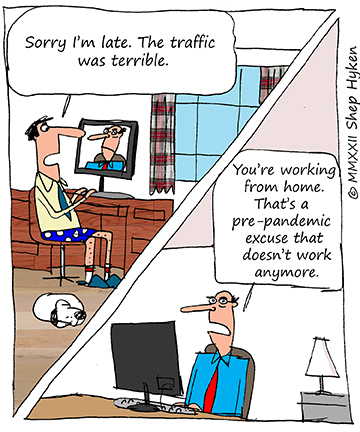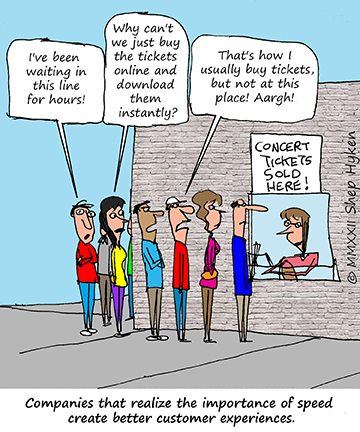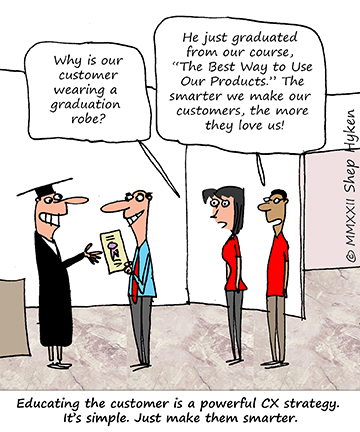Shep Hyken's Blog, page 68
March 4, 2022
Guest Post: Deliver a Total Customer Experience
This week we feature an article by Mike Macpherson, Director of Sales and Marketing for VBO Tickets, a global provider of a total ticketing engagement solution. He shares how organizations can deliver a total customer experience.
What is the total customer experience?
Customer obsessive, customer-focused, customer-centric, the idea is to take customer service to a higher level. Here are four areas that help to deliver a total customer experience.
Listening to the customerWe may not be able to solve every customer’s problem, but we can actively listen to each and every customer. Listening to the customer is very important to implementing a successful total customer experience. Sometimes, the simple act of listening to the customer can turn a negative experience into a positive one. We can learn from the experience, adapt our service levels accordingly, even improve our product from what we learn.
Actively listening to customers demonstrates a real interest in their business and their needs. Customers want to feel you are genuinely trying to understand their concerns and then they want to see you deliver solutions to those concerns. Just like a doctor we frequently ask our customers what their pain points are so we can learn what prescription is required to alleviate those pain points.
Asking the right questions, actively listening, and documenting insights from the customer is one of the most effective ways to provide the right solution. Customers often provide the best means of enhancing the total customer experience.
Take a whole company approach to the customer experienceInvolving everyone in the company with the customer experience changes the entire dynamic. Every department should feel the customer’s pain and know how to eliminate it.
To provide a total customer experience all of the customer touchpoints need to be reviewed and assured of becoming a great experience. While the customer service team is crucial to the company’s purpose, each employee should feel equally responsible for providing customer satisfaction.
If the whole company is focused on the customer experience, everyone can better understand the customers’ needs and what matters to the customer. Every employee will consider how their actions impact the customer and try to give them what they value most. This whole company approach to the customer increases the organization’s effectiveness at delivering a successful total customer experience.
Engage the customerToday’s customers expect a relationship with who they do business with that goes beyond just using products. The goal is to involve the customer in a relationship with the brand that becomes a part of their daily lives.
Engage the customers by providing helpful content in blogs, emails, social media posts, videos, or podcasts. For this strategy to work, the content has to be truly useful and not just a sales pitch in disguise. Instead of asking how we can sell to customers, we ask them how we can support them. We want to offer customers something they want in exchange for their valuable time and attention.
Another effective customer engagement strategy involves opening a means for customers to converse with the brand and other customers on a regular basis. Breaking the ice in social media forums such as LinkedIn, Facebook, and Instagram is a great way to get the dialogue rolling. To engage customers in this way we want to keep the conversations frequent and relevant.
Engaging customers is also done well through stories. Inspiring your customers by sharing the brand’s vision and its impact on the lives of other people.
Engaging with customers means building a positive ongoing connection. This process doesn’t occur over one transaction. It is sustained by ensuring each and every customer touchpoint is a consistently great experience.
Invest in your peopleTo deliver a good customer experience, we want to hire great people who enjoy helping others and solving problems. Taking time to properly hire, train, and motivate new hires will prove well worth the investment.
Hiring people with the right attitude is even more important than hiring people with the right skill set. The organization’s attitude determines how they interact with customers and how far they are willing to go to help provide a great total customer experience.
To find the right people, look for a good blend of empathy, initiative, and shared values. Empathy enables employees to put themselves in the customers’ shoes and understand how they feel. The initiative enables employees to identify the customers’ problems and take action to fix them. Shared values empower employees to be enthusiastic about the company’s core values.
Mike MacPherson is the Director of Sales and Marketing for VBO Tickets, a global provider of a Total Ticketing Engagement Solution. They help organizations boost ticket sales with integrated customer relationship management, ticketing, fundraising, merchandise sales, virtual engagement, and marketing solutions.
 For more articles from Shep Hyken and his guest contributors go to customerserviceblog.com.
For more articles from Shep Hyken and his guest contributors go to customerserviceblog.com.
Read Shep’s latest Forbes article: Customer Loyalty Month Is In April—Are You Ready?
The post Guest Post: Deliver a Total Customer Experience appeared first on Shep Hyken.
March 2, 2022
Never, Never, Never Be Late
 Never being late … that’s not realistic. It’s going to happen. It’s not a question of if. It’s when.
Never being late … that’s not realistic. It’s going to happen. It’s not a question of if. It’s when.
But you might say, “It’s not my fault!” And maybe it’s not. For example, you may be driving to a lunch meeting, and a car accident shuts down the highway making you. And it’s not just about arriving late to a commitment. It could be a delay in shipping a product. Maybe a customer orders something three days before Christmas. You ship it out that day, but the backup at the post office causes a delay. Or perhaps there is a supply issue, and you can’t get the parts to manufacture your products.
None of these scenarios are your fault, but the customer doesn’t always see it that way. All the customer knows is that you were late. I would agree that there is nothing you can do about being late in some cases, but there are steps you can take to keep your customer happy – at least somewhat happy. It’s pretty simple. Be proactive and reach out to the customer before they notice the problem. And when you do inform, consider this as you compose your message:
You must state the facts. You are going to be late. Apologize and acknowledge the inconvenience. Practice transparency with a clear explanation. Make a promise of a new date/time. It could be 15 minutes late for a meeting or 15 days (or more) late for a shipment. Be realistic. You don’t want to have to do this again. Keep the customer updated with ongoing messages as needed.Customers want and expect you to be proactive with your communication, especially if something is wrong. Our customer service research found that 81% of them (over 1,000) customers we surveyed expect companies to reach out to them as soon as possible if there is a problem with their order or service.
So, call the customer when you hit the traffic versus two minutes before you are supposed to be at lunch. Track the shipments on behalf of your customers and let them know when their package is supposed to arrive. And if there are supply issues, you typically learn in advance, so let your customers know, too.
Never being late is not realistic. “Stuff” happens. It’s how you handle it that’s important. It’s simple. Just tell them. Never being late is the goal, and always keeping the customer informed is required.
Shep Hyken is a customer service expert, keynote speaker, and New York Times, bestselling business author. For information on The Customer Focus customer service training programs, go to www.thecustomerfocus.com. Follow on Twitter: @Hyken
customer service training programs, go to www.thecustomerfocus.com. Follow on Twitter: @Hyken
(Copyright © MMXXI, Shep Hyken)
The post Never, Never, Never Be Late appeared first on Shep Hyken.
March 1, 2022
Amazing Business Radio: Chris Wallace
 Does Your Frontline Team Believe in Your Brand?
Does Your Frontline Team Believe in Your Brand?The Gap Between Your Marketing Message and Frontline Teams
Shep Hyken interviews Chris Wallace, Co-Founder and President of InnerView, a marketing consulting firm that helps companies align their brand and product stories with their customer-facing teams. They discuss the importance of a two-way dialogue between the marketing department and your frontline teams.






 Top Takeaways:Do you know what the people talking to your customers think of you? The employees who talk to your customers, the people who represent you, are the gatekeeper of your brand’s message.Just because people get a paycheck from the brands that they represent, it doesn’t mean that they can deliver every message perfectly, or that their training is going to stick.The people who live in the trenches have a unique perspective on the customer experience and the brand promise. They get feedback from customers. They see how decisions are made in real-time. They have valuable input that can help leaders make better decisions. Leadership needs to take advantage of their knowledge!The goal of marketers is to reach the customer, to drive demand, to catch interest, to capture attention, and to set expectations. We encourage marketers to ask themselves – How do we equip our people to understand, align, and confidently deliver on these expectations?The base level of what customers expect from you continues to go up. They can buy the product that you are selling elsewhere. What customers are looking for are the brands that can deliver that extra layer of value. They are looking for the best company who creates the most amazing service.Quotes:
Top Takeaways:Do you know what the people talking to your customers think of you? The employees who talk to your customers, the people who represent you, are the gatekeeper of your brand’s message.Just because people get a paycheck from the brands that they represent, it doesn’t mean that they can deliver every message perfectly, or that their training is going to stick.The people who live in the trenches have a unique perspective on the customer experience and the brand promise. They get feedback from customers. They see how decisions are made in real-time. They have valuable input that can help leaders make better decisions. Leadership needs to take advantage of their knowledge!The goal of marketers is to reach the customer, to drive demand, to catch interest, to capture attention, and to set expectations. We encourage marketers to ask themselves – How do we equip our people to understand, align, and confidently deliver on these expectations?The base level of what customers expect from you continues to go up. They can buy the product that you are selling elsewhere. What customers are looking for are the brands that can deliver that extra layer of value. They are looking for the best company who creates the most amazing service.Quotes:“There is nothing better than dealing with somebody on the frontlines that truly believes and cares about the brand that they represent”
“Look at your frontline teams as an audience to be convinced, not just to be told and informed.”
“Customer experience is the new battleground in business. It shapes whether customers are going to be loyal or leave after one bad interaction.”
“The brand and the customer experience are becoming synonymous.”
“There is a gap between what frontline leaders think of their experiences and what customers think their experience is. As soon as you start asking the front lines to share their thoughts and opinions, you’re automatically ahead of the game.”
About:Chris Wallace is the Co-Founder and President of InnerView. Chris and his team have developed the Brand Transfer Study tool which helps companies measure brand message alignment and engage their frontlines in innovative new ways.
Shep Hyken is a customer service and experience expert, New York Times bestselling author, award-winning keynote speaker, and your host of Amazing Business Radio.
This episode of Amazing Business Radio with Shep Hyken answers the following questions … and more:
What is a brand promise?Who are your internal customers?How do you ensure brand alignment?How can frontline insights improve customer experience?Why is it so important to have a two-way dialogue between the marketing department and your frontline teams?The post Amazing Business Radio: Chris Wallace appeared first on Shep Hyken.
February 28, 2022
5 Top Customer Service Articles of the Week 2-28-2022
Each week I read many customer service and customer experience articles from various resources. Here are my top five picks from last week. I have added my comment about each article and would like to hear what you think too.
It’s Time to Change How We Build Companies & Brands by Chris Malone(Fidelum Partners) As the COVID-19 pandemic subsides, we need to change the way we think about and build companies, brands and customer relationships. Most of the systems and processes we use to engage in commerce were built with an emphasis on competent and efficient execution of transactions. As a result, thoughtful customer experiences that inspire trust and lasting loyalty are rare.
My Comment: Here’s a new idea. Consider how “warm” you are with your customers. How much empathy, care, passion, etc. can be summed up with the idea of you and your customers warming up to each other. It’s all about how customers relate to and with the brand. I found this article fascinating, and I think you will, too!
2022 – Time to Make the Move Beyond Cx and Ex to Total Experience by Candice Mueller(diginomica) More recently, organizations have realized the importance of Employee Experience. Research shows happy employees out-perform competitors by 20%, are 12% more productive, 65% more energetic and take 10 times fewer sick days. Likewise, happy salespeople drive 37% more sales — and now we have an array of dedicated Employee Experience tools.
My Comment: Customer experience (CX) has been at the top of many company’s success strategies for years. Then along came the employee experience (EX). Recently, there has been much written about how the two belong together. When you combine them, you get a Total Experience (TX). That alone should intrigue you enough to want to read this informative article.
How to Enhance Customer Loyalty: 6 Tips to Make Loyalty Great Again by Julia Morrissey(NewStore) The pandemic fundamentally changed the way we interact with businesses. Big meetings don’t have to be done in person. “Going to the movies” doesn’t necessarily mean you’re going into a theater. And patronizing your favorite restaurant could mean DoorDash delivery to your kitchen.
My Comment: If customer loyalty is important to you and your business – and you know it is – then you will enjoy this article. Here are six tips that can drive more loyalty. My favorite is number three, which focuses on personalizing the experience.
Customer Experience (CX) Continues to Boom, Putting Customers First by Alon Ghelber(PaymentsJournal) It is not uncommon for individuals to state that they have gone above and beyond to solve a customer’s problem. In this way, businesses could link customer service to customer experience as they have reacted to a customer’s issue. However, it is essential to realise that customer service is just a facet of a holistic customer experience strategy. While customer service is essential, it is a reactive action by a business and usually means that it does something memorable only when something goes wrong.
My Comment: If there is nothing else you get from this article, remember this line: “… it is essential to realize that customer service is just a facet of a holistic customer experience strategy. It takes more than just customer service to create a great CX, although that’s a good place to start!
Cx Trends for 2022: Comfort, Creativity, Convergence, Change by Carina Rolley(Retail Customer Experience) What can customer experience teams expect in the year ahead? It’s not just more of the same. We expect to see a stronger emphasis on inspiring consumer confidence, a growing need for brand differentiation, converging CX-related functions, and a new focus on creative work that leverages data insights. Here’s what CX teams can prepare for now and deliver on in 2022.
My Comment: If you want to build a relationship with your customers that gets them to come back, then pay attention to the first two of the four ideas/trends shared in this article, which is to create an emotional connection and inspire confidence. It seems obvious, but if that were true, more companies would be focusing on these two very important ideas?
BONUSES5 Lessons From the 2022 Cx “global Gurus” on Future-facing Customer Experience by Jeanne Bliss(Customer Bliss) If you’re looking for resources to share with your team on experience leadership, I encourage you to take a look at the authors on this year’s Global Gurus list of customer experience leaders for inspiration (a sincere thank you to Global Gurus for including me in the list once again). Over the last two years, I’ve had the pleasure of interviewing many of the people on the list, so I’ve pulled out some of my favorite highlights from our conversations that look to the future of experience leadership.
My Comment: Fellow customer experience expert, Jeanne Bliss, shares five important CX topics with links to the interviews from her podcast. Excellent interviews with five other CX experts. (Thank you, Jeanne, for including me in this list!
Ecommerce Leaders Tell All: 10 Trends and Predictions for 2022 by Namogoo(Namogoo) Curious about what’s next in the world of eCommerce? We reached out to eCommerce influencers and asked: “What do you think will be the biggest eCommerce trend in 2022, and why?” These influencers did not hold back. From AI technology to personalization, these successful eCommerce experts shared their trends, predictions, and strategies for how to engage shoppers, reach profit goals, and drive eCommerce brand success in the upcoming year.
My Comment: Here’s another list of CX experts sharing their insights. This time it’s 10 trends and predictions for the eCommerce industry in 2022.
[image error]Shep Hyken is a customer service expert, professional speaker and New York Times bestselling business author. Go to The Customer Focus to learn more about our customer service training programs. Follow on Twitter: @Hyken
to learn more about our customer service training programs. Follow on Twitter: @Hyken
The post 5 Top Customer Service Articles of the Week 2-28-2022 appeared first on Shep Hyken.
February 25, 2022
Guest Post: The Shocking Percentage of Customers Who’d Leave Your Business Due to Bad Service – and What You Can Do About It
This week we feature an article by Janine Hunt, Client Partnership Director at Kura, a company that provides customer service solutions by outsourcing contact center services and software solutions. She shares how customer service is the deciding factor to your customer’s loyalty to your business.
According to Forbes, 96% of customers would leave your business if you deliver a bad customer experience.
No, that’s not a typo. Ninety-six percent are likely to leave.
In saturated markets, customer service is a key differentiator. Consumers have a multitude of options available to them nowadays, so it’s easy for them to leave your business for a competitor. Many businesses may not be prioritizing customer service due to budget restraints, but it’s one of the worst things you could do.
Customer service: the statisticsLet’s take a deeper look at the statistics. Of the 96% of customers who’d consider leaving your business, 27.9% would be extremely willing to switch to another business for a better service, while the rest would be very or somewhat willing.
Customer service is essential to the loyalty of your clients. Loyalty leads to customer retention, and retention is vital for businesses because the cost of acquiring new customers is on average five times higher than retaining your existing clients. What’s more, increasing your customer retention by just 5% can see your business boost its profits by up to 95%! This is, in part, because happy customers are more likely to recommend your business to others.
If your customer service isn’t up to scratch, you risk falling behind the competition. Two-thirds of businesses now use their customer service as a unique selling point (USP) to help them stand out in the market, compared to 10% in 2010. If your customers are looking elsewhere because of poor service, your competitors are targeting them by promoting their service.
How can you improve your customer service?Now that you know how critical it is to deliver an outstanding customer experience, how can you achieve it? A good customer experience has many elements, and taking them all into account is important to keep your customers happy.
Customer service starts with peoplePeople like to talk to people. While customers can self-serve online now, sometimes they still need to get in touch with your employees directly. And your people can make or break that experience. Hiring people who are genuinely passionate about delivering a great customer experience is essential. Businesses that need large customer service teams often feel pressured to hire anyone competent, but that can result in poor service.
Training is also important to make sure your advisors are all on the same page. The last thing your customers need is an inconsistent experience. Your training program will also help to instil your business’ values into your customer service team so they’re driven by them in each interaction.
Empathy and understanding are essential traits for customer service advisors. If customers feel like they aren’t being listened to or understood, they’ll chalk the experience up as bad customer service. Good communication skills, accountability, courage, and a willingness to go above and beyond are essential for customer service advisors. So, make sure your advisors can deliver all of this for customers.
Make sure you have the right employee numbersIt’s also critical to have enough people to deal with your customer queries. Businesses that don’t have enough advisors will often make it more difficult to speak to a live advisor, and unsurprisingly, this is the biggest frustration for customers. Whether it’s automated phone options, chatbots, or circular website contact pages, not having the option to speak to a human is the worst thing you can do for your customers.
Too few advisors can also have the impact of causing long wait times – another key frustration for customers. This can also cause stress for your employees, who may try to rush through interactions knowing there’s a large queue of customers waiting. Hiring an adequate number of talented and passionate advisors can be a time and cost-intensive exercise, and it’s not achievable for many businesses, so you may want to consider customer service outsourcing. Tapping into the experience of a business dedicated to servicing customers, with a depth of advisors that may not be attainable in-house, can dramatically improve your customer service output.
Offer an omnichannel experienceAs our world becomes increasingly digital, it might seem like offering more traditional customer service channels, such as face-to-face meetings and phone calls, isn’t necessary. But that’s not the case. While the number of customers who only want digital contact options rose from 10% to 21% between 2019 and 2020, 71% of customers still want a blend of physical and digital channels.
Offering multiple channels will not only allow you to meet these customers’ expectations, but it’ll also ensure that you are catering to all of your customer demographics. There’s a generational divide in customers’ channel preferences, with younger customers opting for digital communication while older generations choose channels like in-person and phone calls. People over 65 and those on low incomes are less likely to feel comfortable with their digital skills or have access to the internet, so it’s vital to ensure those customers can still reach you.
Some businesses offer a blend of channels, but if your resources are limited, it’s important to know which ones to focus on. The top five channels that customers expect when dealing with a business are email, live chat, website, voice calls, and SMS messages. Make sure that customers can experience a seamless transition between channels or departments too – 73% will reconsider their relationship with a business if they have to repeat their problem over and over again.
Customer service has never been more important to your clients or your business. It’s a deciding factor when it comes to your customer’s loyalty to your business, and even one bad experience could see one in three customers leave. Without a batch of loyal customers, it can be difficult to increase your profits and grow your business to others; your business will struggle to survive. By improving these three areas of your customer service, you can boost your business’ client retention, reputation, and even profits.
Janine Hunt is the Client Partnership Director at Kura, a company that provides customer service solutions by outsourcing contact center services and software solutions.
 For more articles from Shep Hyken and his guest contributors go to customerserviceblog.com.
For more articles from Shep Hyken and his guest contributors go to customerserviceblog.com.
Read Shep’s latest Forbes article: Let’s Give Them Something To Talk About—And Other Songs About Customer Experience
The post Guest Post: The Shocking Percentage of Customers Who’d Leave Your Business Due to Bad Service – and What You Can Do About It appeared first on Shep Hyken.
February 23, 2022
The Light Switch Mentality
 When you flip a light switch, you know exactly what to expect. The light comes on – right away. No hesitation. It happens immediately.
When you flip a light switch, you know exactly what to expect. The light comes on – right away. No hesitation. It happens immediately.
The human brain loves instant results. Let’s use the TV as an example. It was a number of years ago, but I remember the frustrating feeling like it was yesterday. I switched to a new satellite system for the internet and TV. Before the switch, when I changed TV channels it was instant. Go up, go down or push the number pad to get a specific channel, and it worked instantaneously. But with the new system, it took three or four seconds, sometimes longer depending on the signal, to move from one channel to the next. It might as well have been three minutes! Call me impatient – because I am. I ended up switching back to my old cable and internet company.
The point is that people don’t like to wait. They tolerate having to wait, but given the choice, they would rather not do so. Just do a Google search of “How long do we spend waiting in lines?” and you’ll get different answers, ranging from six months to 10 years of our lives. Let’s be conservative and go with six months. That’s still a lot of unproductive time, and you don’t get it back.
Customers dislike standing in line so much that some will pay to have someone else stand in line for them. That’s one of the services offered by TaskRabbit – actually hiring someone, referred to as a “Tasker,” to stand in line for you.
The point is that people would rather not wait. They want to get information quickly and easily. Consider that when you order an item from Amazon, you are immediately sent confirmation that your order has been placed.
Great customer-focused companies make it easy to get information quickly. It might be a Frequently Asked Questions page on the company’s website or a video tutorial that teaches exactly what the customer needs without having to call customer support. The point is that it’s quick, painless, and takes very little effort.
Companies that realize the importance of speed are gaining a competitive advantage. One salesperson calls a customer back within an hour, while another salesperson calls back in two days. Who do you think creates more trust and confidence and has a better chance of making the sale? (Obviously, that’s a rhetorical question.)
In most cases, we can’t be as instant as a light being switched on and off. But recognizing that people have shorter attention spans, as in a Light Switch Mentality, will remind us to react faster to our customer’s needs, ideally meeting and even exceeding their expectations.
Shep Hyken is a customer service expert, keynote speaker, and New York Times, bestselling business author. For information on The Customer Focus customer service training programs, go to www.thecustomerfocus.com. Follow on Twitter: @Hyken
customer service training programs, go to www.thecustomerfocus.com. Follow on Twitter: @Hyken
(Copyright © MMXXI, Shep Hyken)
The post The Light Switch Mentality appeared first on Shep Hyken.
February 22, 2022
Amazing Business Radio: Stephanie Coradin
 Teaching Employees How to Smile
Teaching Employees How to SmileServing Internal Customers First
Shep Hyken interviews Stephanie Coradin, founder of DEMBO Inc and an advocate of employee empowerment and dynamic leadership. They discuss how leaders can empower your customer service team by serving their internal customers first.






 Top Takeaways:Teaching employees how to “smile” starts with having employees feel comfortable in their skin, having them feel like they are in a place where they can, and allowing them to take ownership.The external customers are important, but the people that are going to serve those customers are also our customers, known as internal customers. We must properly serve our internal customers, even before we send them out to serve others.We tend to send an experienced employee out to serve customers without allowing them to take a breath and find out what they need from us as leaders. We send them out and they’re not able to find out what their guests need from them because they’re modeling how their leaders treat them.Every leader needs to understand their leadership style. Understanding their style allows them to adjust to the different personalities and styles of their team members.Have conversations with your team to better understand what they need from you. Ask them, “What can I do to help you move further into your career or into this position?”We have a cultural problem where employees are afraid to speak up. They are afraid they will get punished if they do something wrong or if they say something that may be viewed as negative toward their manager. We have to put them at ease so they know it is okay to speak up.Quotes:
Top Takeaways:Teaching employees how to “smile” starts with having employees feel comfortable in their skin, having them feel like they are in a place where they can, and allowing them to take ownership.The external customers are important, but the people that are going to serve those customers are also our customers, known as internal customers. We must properly serve our internal customers, even before we send them out to serve others.We tend to send an experienced employee out to serve customers without allowing them to take a breath and find out what they need from us as leaders. We send them out and they’re not able to find out what their guests need from them because they’re modeling how their leaders treat them.Every leader needs to understand their leadership style. Understanding their style allows them to adjust to the different personalities and styles of their team members.Have conversations with your team to better understand what they need from you. Ask them, “What can I do to help you move further into your career or into this position?”We have a cultural problem where employees are afraid to speak up. They are afraid they will get punished if they do something wrong or if they say something that may be viewed as negative toward their manager. We have to put them at ease so they know it is okay to speak up.Quotes:“Understanding how you lead first makes it so much simpler for you to go through the steps of leading another, whether it is a team or just one person.”
“Employee empowerment is providing your team members with the tools, the training, and the opportunities that they need to do their job – and then letting them do it.”
“Because we think differently, we approach problems differently depending on our backgrounds and our cultures.”
“Know yourself and know what you’re looking for. Be clear about who you are and how you work. That makes a world of a difference.”
About:Stephanie Coradin is the founder of DEMBO Inc, she has over 18 years of experience in providing leadership and development training, and life coaching to individuals and groups from varied industries. Stephanie is an advocate of employee empowerment and dynamic leadership.
Shep Hyken is a customer service and experience expert, New York Times bestselling author, award-winning keynote speaker, and your host of Amazing Business Radio.
This episode of Amazing Business Radio with Shep Hyken answers the following questions … and more:
What is employee empowerment?Why is employee empowerment important?What is the difference between internal and external customers?What is dynamic leadership?Why is it important to understand your leadership style?The post Amazing Business Radio: Stephanie Coradin appeared first on Shep Hyken.
February 21, 2022
5 Top Customer Service Articles of the Week 2-21-2022
Each week I read many customer service and customer experience articles from various resources. Here are my top five picks from last week. I have added my comment about each article and would like to hear what you think too.
Are Lifelike Digital Humans the Future of Customer Experience? by Rebecca Bellan(TechCrunch) Soul Machines, a New Zealand-based company that uses CGI, AI and natural language processing to create lifelike digital people who can interact with humans in real time, has raised $70 million in a Series B1 round, bringing its total funding to $135 million. The startup will put the funds toward enhancing its Digital Brain technology, which uses a technique called “cognitive modeling” to recreate things like the human brain’s emotional response system in order to construct autonomous animated characters.
My Comment: Is this the future of customer service? Talking to an avatar – a digital human – with almost lifelike features, and most important, responses? I wouldn’t be too concerned about this taking away a lot of jobs. My opinion is that this technology ups the customer experience related to lower-level needs. It’s more aesthetically pleasing than just texting with a chatbot or interacting on the phone with voice response technology. READ MORE
How to Use Content Marketing for Customer Retention and Loyalty by Express Computer(Express Computer) It is indeed an undeniable fact that customers that are happy and satisfied tend to stick around for long. However, this can only be done by adding value to customer experiences which keeps them engaged and further paves the way for customer retention and loyalty. Content marketing plays a pivotal role in helping businesses in creating a loyal customer base and connecting with them effectively.
My Comment: Content marketing, done right, is more than just traditional promotion. It also adds to the customer experience. This short article makes some good points. Consistency, building a community via social media, and a personalized approach are just three of the topics the author addresses. READ MORE
How To Be A Customer Experience Clairvoyant by Chip Bell(Forbes) Wise organizations look beyond customer needs and expectations to their hopes and aspirations. They leave the realm of “what is” to explore “what might be.” Speculation about what will be appealing to customers is grounded in savvy customer research that includes attentive listening and thoughtful learning about customer dreams.
My Comment: What if you could read your customers’ minds? Think of how well you could serve those customers if you knew what they were thinking. Well, you can’t read minds, but if you asked the right questions, you might get more insight into what the customer is thinking. The author quotes Andrew Grove, founder of Intel, who wrote, “Breakthroughs come from an instinctive judgment of what customers might want if they knew to think about it.” If you want customers to “think about it,” ask the right questions. In this excellent article, you’ll learn ways to get inside your customers’ heads and better understand what they need, want, and expect. READ MORE
Who Thinks You’re Customer-driven, You or Your Customers? by Ruben Ugarte(MarTech) It’s hard being a customer. Why do we keep coming across hurdles to purchase the products or services we want if we are so important? Think of the examples where buying was a frustrating experience.
My Comment: There is often a gap between what a company/brand executive perceives as giving good customers service and what their customers perceive it to be. This gap can be a real problem. Typically it’s the executive thinking it’s better than it is. This short article has several suggestions on how to close that gap. READ MORE
The Value Gap a New Blueprint for Customer Expectations by Quinine(Quinine) Brands continually need to work hard to understand the new priorities of consumers, as what they value changes, and what they need and want from their physical retail experiences shifts.
My Comment: Speaking of a gap, how about the value gap, which is what this excellent article is about. And in this case, the gap is good. The author defines the value gap as when the customer experiences value unexpectedly. It’s when consumers feel like they’ve won the lottery. So we want our customers to experience this gap, and the author has handed us 15 business and store factors (for the retailers) that will drive the perception of great value. READ MORE
BONUSACSI: Customer Satisfaction Decline Continues — Here’s a Big Reason by Marianne Wilson(Chain Store Age) The ACSI noted that, during much of the 1990s, there was a sharp decline in customer satisfaction. But as businesses began to realize that customer loyalty was often contributing more to profits than increased market share, there was a shift toward a greater focus on customer satisfaction and the index increased sharply over many years.
My Comment: We close out this week with a bonus article about the state of customers service. The ACSI (American Customer Satisfaction Index), shows a decline in customer satisfaction to the lowest level since 2005. This is more of a “state of the industry” article that should serve as a wake-up call for those who aren’t focusing enough attention on customer service and experience. READ MORE
[image error]Shep Hyken is a customer service expert, professional speaker, and New York Times bestselling business author. Go to The Customer Focus to learn more about our customer service training programs. Follow on Twitter: @Hyken
to learn more about our customer service training programs. Follow on Twitter: @Hyken
The post 5 Top Customer Service Articles of the Week 2-21-2022 appeared first on Shep Hyken.
February 18, 2022
Guest Post: Ways to Improve the SaaS Customer Experience
This week we feature an article by Anand Subramanian, a content writer from Freshflows, a product management app for B2B SaaS product teams. He shares how to improve the SaaS customer experience to encourage customer loyalty.
Software as a service (SaaS) has grown rapidly in recent years, particularly in recent months. A distinctive product is no longer sufficient. It’s easy to miss the new B2B buyer demands. Many SaaS firms neglect their current clients to acquire new ones. Profits from loyal customers are a company’s most valuable asset. So, while creating a product, focus on customer success to ensure customer satisfaction and reduce churn. A happy client is more likely to become a loyal one who can help you boost income. So, offering a pleasant customer experience is critical to the success of your organization.
Why is it Important?Generally, obtaining new clients is more expensive than retaining existing ones. It’s tough to keep customers and get repeat business if you don’t prioritize client pleasure. A SaaS firm depends heavily on client retention and repeat business. Customer experience is a key difference for SaaS firms. If your first-time customers aren’t happy, you’ll lose them shortly.
Now that we know its importance, let us consider ways to improve customer experience.
Investing in Best Website UXEvery company needs a proper online user experience, but SaaS firms need it more than others. This is because your website is generally your customers’ primary point of contact. They’ll use your site to do things like research information, get support, and compare costs. Your website must provide an exceptional user experience.
What are you doing wrong? Difficulties in your site might discourage potential customers from buying it. Assume your website includes:
Slow website loading times, ambiguous website content, ineffective navigation, page issues, lack of mobile compatibility Calls-to-Action are absent (i.e. demo or trial registrations)By optimizing sites that cause these sorts of problems, you’ll be on the right track to a better client experience.
Consumer Onboarding ExperienceYou can start your customers off right with a great onboarding experience. It’s one of the most effective ways to increase client satisfaction. Your onboarding process should be tailored to your customers’ needs to help them feel welcomed and supported from the start.
Here are 2 ways of achieving successful onboarding
It begins when customers join up for your service. These may be freemium or paying customers. Non-paying users may become loyal and lucrative customers, therefore welcoming everybody is vital. Your welcome message should thank new members for joining. It should be delivered immediately so they don’t forget. When appropriate, it should provide guidance on how to get started and connect them with a resource. The next step is to help new customers set up and use your product. Onboarding is incomplete without it. Recognize that each user’s onboarding needs will vary. Others may be new to your SaaS product and need extensive training. Offering self-service materials and guided walkthroughs helps clients get what they need. Plan for collecting and acting on consumer feedback.After onboarding and orientation, your customers are ready to utilize your SaaS products. They purchased or subscribed to your product to solve an issue or alleviate a pain point. However, clients may run across obstacles along the way that detract from their experience. How will you know whether your product satisfies their expectations? To find out, you must regularly seek user input.
There are various efficient approaches for SaaS organizations to gather client feedback in order to assess their entire customer experience.
Consumers may offer rapid feedback by emailing or posting surveys on your website. You might ask them whether they like your products and if there are any issues that need to be addressed. You may also examine a variety of metrics derived from consumer usage data in your app, such as how much time customers spend using it, retention and engagement data, and behavioral analytics. This data may give extra insights into how users interact with and utilize your app.Create an action plan based on the input you received. Your SaaS experience management strategy will reap rewards as you continue to gather and act on feedback.
Deconstruct internal silosInternal organizational silos are known in B2B SaaS. Whether you are a small start-up or an enterprise SaaS firm, your users may suffer when your teams are not aligned. For example. Features that are promised but never delivered may indicate sales, marketing, and customer experience silos that need to be addressed. It is tough to do business with customers in silos, decreasing loyalty and increasing churn.
To get your staff on the same page, create internal teams entirely focused on customer success. A customer success team helps convert prospects into regular users. Keeping an eye on the customer journey can help your team uncover ways to boost engagement and retention.
Customer Experience MeasurementHow can SaaS companies measure and improve customer satisfaction? You can track improvements in your CX by measuring key customer experience KPIs. Here are some customer success metrics to consider when developing a data-driven customer success strategy:
NPS: NPS measures how likely a customer is to refer your items to a friend. Positive client recommendations are vital to B2B organizations, therefore achieving a high NPS is a common goal for customer care teams. The Net Promoter Score is calculated by subtracting the percentage of “detractors” (ratings 0-6) from the percentage of “promoters” (rating of 9-10). It’s an essential factor to consider when assessing current client satisfaction. Customer Lifetime Value: Customer support teams should also aim to increase client lifetime value. It’s simple to calculate CLV. Calculate your average buy value by multiplying it by your average purchase frequency. The result will inform you how much your company can expect to earn throughout the lifetime of each new client, a key statistic for evaluating your customer success initiatives. The Churn Rate: The churn rate is a measure of loss over a certain period, and there are two forms of churn: revenue churn and customer churn. To begin, revenue churn is the percentage of revenue losses over time. It is the revenue lost due to subscription cancellations or downgrades. Customer churn rate is more often used by SaaS companies and deals with lost clients. The churn rate is calculated by dividing the total number of customers by the total number of churned customers. If your churn rate is higher than the industry average, your customers aren’t happy with the results of your SaaS solutions. ConclusionProviding a great SaaS customer experience has far too frequently been an afterthought. But, in these competitive times, it can’t last. Your company should adopt a customer-centric strategy by soliciting input, acting on it, and assessing progress so that you know where you stand.
Anand Subramanian is a Chennai-based visual artist and content writer. He has a diverse background in visual arts, teaching, and publishing, which has earned him recognition from national and international publications such as Lonely Planets Magazine India, Outlook Traveller, Broad Magazine, and Travel Leisure India. He is a content writer at Freshflows.
 For more articles from Shep Hyken and his guest contributors go to customerserviceblog.com.
For more articles from Shep Hyken and his guest contributors go to customerserviceblog.com.
Read Shep’s latest Forbes article: Amazon Or Nike? Who Should Buy Peloton
The post Guest Post: Ways to Improve the SaaS Customer Experience appeared first on Shep Hyken.
February 16, 2022
Make Your Customer Smarter: Create an Educational Experience
 It’s natural that you would gravitate toward a person you perceived as an expert. When someone demonstrates a level of expertise and shares information you didn’t know, you tend to trust them. That expertise creates confidence.
It’s natural that you would gravitate toward a person you perceived as an expert. When someone demonstrates a level of expertise and shares information you didn’t know, you tend to trust them. That expertise creates confidence.
For example, when you go to Best Buy and are looking for a new TV, you’ll find there are so many to choose from. Even when they have them all hanging on a wall, turned on so you can compare the quality of the pictures, it’s still confusing as to why one would be so much more expensive than another. They are the same size, and many have similar great pictures. So which TV should you buy?
It’s the salesperson’s job to help you make that decision. And there are two types of salespeople. One will read the specs on the card below the TV. The other will share the same information, but at the same time will educate you why one is better – or not – than another. They will explain the “why” behind the specs on the card. And in a very short time, you trust them and take their recommendation. And it’s not just because they are really smart. It’s because they educated you and made you smart!
When you make a customer smarter, at least two things are happening. One, you’re showing off your knowledge in such a way that is all about the customer, and not just about how much you know. And second, you’re eliminating confusion, which creates clarity and confidence.
Confidence is very important to get a customer to not just buy but to come back and buy some more. Customers must have confidence in the quality of what you sell and confidence that the experience will be the same every time. And when you can add that you make the customer smarter – and therefore more confident about their buying decisions – you are hitting the trifecta that can increase the odds of repeat business and possible customer loyalty.
Most customers, whether they are conscious of it or not, want to make informed decisions. They want to feel good and confident about what they are buying. Educating customers and creating clarity is a great way to separate yourself from others who might not be willing to take an extra minute or two to help the customer become smarter so they can make smarter buying decisions.
Don’t think this is a sales technique. Creating an educational experience is a powerful customer experience strategy. It’s simple. Just make your customers smarter.
Shep Hyken is a customer service expert, keynote speaker, and New York Times, bestselling business author. For information on The Customer Focus customer service training programs, go to www.thecustomerfocus.com. Follow on Twitter: @Hyken
customer service training programs, go to www.thecustomerfocus.com. Follow on Twitter: @Hyken
(Copyright © MMXXI, Shep Hyken)
The post Make Your Customer Smarter: Create an Educational Experience appeared first on Shep Hyken.



